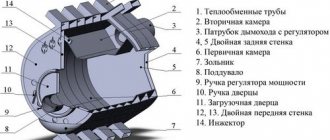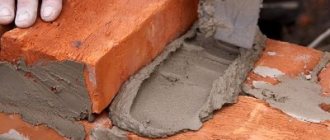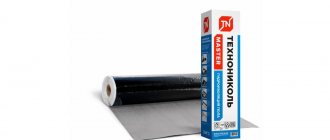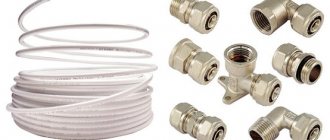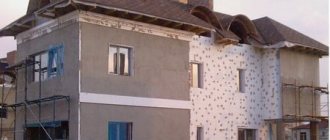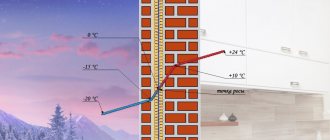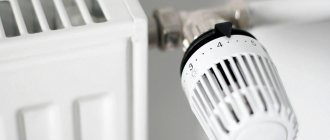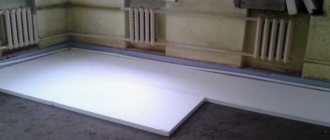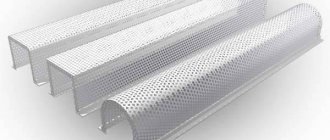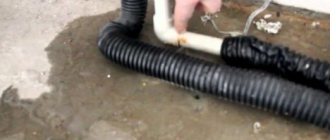Winter temperatures in the vast majority of Russian regions leave practically no chance for pipelines to remain intact without reliable thermal insulation. Insulation for pipes made of foamed polyethylene is an excellent way to protect utility lines from low temperatures, and when used on heating mains, prevent unnecessary heat loss.
Insulation for pipes made of foamed polyethylene
This material is inexpensive, easy to install, lightweight, produced in a wide variety of sizes, and has a number of other important advantages. It makes sense to get to know him better - he will definitely find a use in any household.
Areas of application of polyethylene foam insulation
Foamed polyethylene for pipes is widely used for thermal insulation of sewer and water pipes laid underground, across the street or passing through insufficiently well-heated rooms. The presence of insulation guarantees that the transported coolant, water or sewage will not freeze in winter at subzero temperatures.
Due to the fact that all pipes produced for household utilities are made of materials with high thermal conductivity, such as steel, fiberglass and polymers, their freezing occurs quite quickly. Therefore, their insulation is simply necessary.
When a liquid in uninsulated pipes freezes and turns into a solid state of aggregation, it is not only capable of creating a plug in the channel that will slow down or completely stop the flow. Everything could be much worse - the expansion of ice has such a “power” potential that even thick metal walls cannot withstand it - they crack or burst.
When water freezes, it expands significantly in volume, which often leads to deformation and bursting of pipes.
Most accidents on central pipelines occur precisely because of insufficient thermal insulation. Therefore, taking into account other people’s mistakes, you should not save on this material, so as not to pay a much larger amount to restore damaged or even completely failed systems.
Even if the pipelines are buried below the freezing level of the soil, thermal insulation is still needed to prevent unnecessary heat losses
Highways laid in trenches dug in the ground are usually installed below the freezing level of the soil. However, hot water supply and heating pipelines carried out in this way also require effective thermal insulation, which will prevent heat loss from the transported coolant or hot water, which allows them to maintain their temperature as much as possible at all stages of delivery to the consumer. For the same purposes and in a similar way, the supply and return pipes in the boiler room are insulated if it is located in a separate unheated room, as well as in areas where they pass through other “cold” rooms.
Almost all materials used for thermal insulation also have sound-proofing qualities, so they are often used to suppress the noise produced by water passing through pipes in residential premises.
The installation of air conditioning systems cannot be done without installing thermal insulation.
Insulation is also required for pipes of air conditioning and cold water supply systems. In these cases, it is intended to prevent excessive formation of condensate, which may appear due to temperature changes between pipes and air, which will inevitably lead to premature wear of the system or destruction of connecting nodes. Thermal insulation material neutralizes this phenomenon, extending the life of trouble-free operation of not only the pipes themselves, but also the devices to which they are connected.
Basic requirements for thermal insulation materials for pipes
In order for the insulation to be effective and the money for its purchase not to be wasted, the thermal insulation material must meet certain requirements:
- Low thermal conductivity of insulation - the lower this indicator, the thinner the layer of material required. This factor becomes important in cases where it is necessary to insulate an already installed pipeline, or there is a need to save on this purchase.
- Hydrophobicity of the heat insulator . This quality should not be underestimated, since the insulation must not only protect the pipeline from freezing, but also from moisture, so that the metal is not subject to corrosive destruction. In addition, if the insulating material becomes moistened, its thermal insulation capabilities will begin to sharply decrease.
- Resistance to mechanical and atmospheric influences - these qualities are necessary both for thermal insulation of pipelines running along the street and for those buried in the ground.
- The heat resistance of the material is a property that is especially necessary for pipelines of heating and hot water supply systems. That is, the material should not “float” when heated around 100 degrees and should not become brittle in the cold.
Foamed polyethylene has all these qualities.
Specifications
Technical characteristics of thermal insulation
The material is made from environmentally friendly components that do not pose a threat to humans. They do not emit any toxins and are not a breeding ground for bacteria.
Important! Energoflex turned out to be very resistant to various environments, including chemical and physical influences.
The description of the energy flex and its characteristics are presented in the table below:
Energoflex, whose technical characteristics are indicated above, is very resistant to biological threats, representing a rather unfavorable environment for the development of bacteria and rotting. During operation, the material does not change its shape and size even under strong external influences. Separately, it is worth noting the good soundproofing qualities of the material.
The substance comes in the form of a soft, elastic material that is fairly light in weight. Even one worker can handle the installation of insulation.
What is foamed polyethylene?
General concepts about polyethylene foam
Any foamed polyethylene, be it insulation for floors, walls or other surfaces of the house or heat insulator for pipes, is made using the same technology, however, the material can have different densities and thicknesses. Insulation for pipes, unlike those produced for flat surfaces, are manufactured in the form of cylinders of different diameters, which greatly facilitates their installation.
Polyethylene foam insulation for pipes is usually produced in the form of cylinders with a certain internal and external diameter. This is very convenient for quick installation
The production technology of this material consists of foaming the polyethylene melt with hydrocarbons, resulting in an elastic elastic fabric that has a bubble structure with closed cells. During the foaming process, under the influence of high temperatures, polyethylene increases in size almost 20 times, and then the finished mixture, after cooling, is passed through an extruder, where it is given a certain shape.
Polyethylene foam is produced in the form of sheets, rolled into rolls, shells (cylinders) and bundles. The material is divided into two types according to the manufacturing method - cross-linked and non-cross-linked.
- Non-crosslinked materials are designated as NPE and are obtained by foaming polyethylene with a mixture of propane-butane or approved freons. Under pressure in the extruder, the raw material is melted and mixed with a reagent (propane-butane mixture). At the exit from the extruder, the pressure decreases, the gas expands the polyethylene, resulting in gas-filled bubbles. At the exit from the apparatus, the finished material cools and hardens, maintaining the shape given to it by the extruder nozzles.
This type of material differs from cross-linked material in its lower density and strength, and less pronounced resistance to aggressive chemical influences. In appearance, it can be identified by larger cells, and when compressed, the material makes a cracking sound and no longer takes its original shape.
The illustration shows uncrosslinked polyethylene foam at the top and crosslinked polyethylene foam at the bottom.
- Cross-linked polyethylene foams (PE-X) are produced in two ways - radiation and chemical. Such materials are called cross-linked because under a certain external influence, cross-links are formed in polyethylene molecules, in addition to their characteristic linear chains - this is “cross-linking”.
The chemical method of forming cross-linked material occurs under high pressure. Polyethylene with the addition of antioxidants and a reaction initiator undergoes melting under the influence of high temperatures. Then, in the molten state, the raw materials are “crosslinked”. The initiators of the formation of cross-links disintegrate at high temperatures, and radicals appear that take away one hydrogen atom from polyethylene. As a result, unsaturated carbon radicals are formed in their place, which combine to form a spatial structure.
The radiation method of cross-linking macromolecules is carried out under the influence of directed energy beams.
Cross-linked polyethylenes are more durable, elastic and have a high density. After applying and removing a deforming load, the compressed material quickly returns to its original state. This property of cross-linked polyethylene - the presence of a kind of “memory” of the original volume or linear size, is widely used in many areas of the economy.
Thermal insulation for pipes is produced in the form of cylinders, usually up to 2000 mm in length, or tubes sold in coils, and the diameter and wall thickness vary. For example, the thickness can be 6, 9, 13, 20 and 32 mm, and the internal diameter of cylinders intended for domestic needs can be from 6 to 200 mm; for industrial use, the figures can be larger.
In order for the thermal insulation to “work” properly, the internal diameter of the polyethylene cylinders must correspond to the external diameter of the insulated pipes. Therefore, manufacturers, knowing this, manufacture products with standard parameters, focusing on the produced range of water and sewer pipes. Insulation cylinders have an even cut along their entire length, often also equipped with an adhesive layer, which allows them to be installed on an already installed pipe without resorting to dismantling.
There is an even cut along the entire length of the insulating cylinder, the end edge of which is often equipped with a self-adhesive layer
To insulate pipelines that are directly exposed to ultraviolet rays, polyethylene foam tubes are produced that have a special polymer colored coating that provides the necessary protection to the heat insulator.
The external polymer coating of the insulating cylinders increases their resistance to negative external influences
Cylinders for pipe insulation can also have a foil coating, which prevents the material from overheating or overcooling.
It should be noted that if it is necessary to insulate complex pipeline structures or large-diameter pipes, roll material can also be used. They wrap water pipes of any diameter in one or several layers and fasten them with special tape.
Waterproof reinforced tape is perfect for performing thermal insulation work on pipelines, especially where fixing the insulation is difficult due to the complexity of the site configuration
In addition to heat insulators for pipes, sleeves are also produced for cable systems. This type of material has a fine-cell structure, so it can also serve as a waterproofing agent, which makes the material almost universal. It is especially important to use this type of insulation for overhead cable lines, which are influenced by various natural factors all year round - temperature changes, moisture, ultraviolet rays, ice, wind, etc.
Prices for polyethylene foam
polyethylene foam
Main technical and operational characteristics of foamed polyethylene insulation
The assortment of construction stores includes pipe insulation made from different materials - mineral wool, polystyrene foam, polyurethane foam and polyethylene foam. In terms of affordability and thermal insulation efficiency, polyethylene foam appears to be the leader.
The characteristics of foamed polyethylene from different manufacturers may vary somewhat, but their average indicators can be estimated:
- For example, a parameter such as density can be 20÷45 for non-crosslinked polyethylene foam, and 25÷200 kg/m³ for crosslinked polyethylene foam.
- The thermal conductivity coefficient is usually in the range from 0.037 to a maximum of 0.040 W/m×°K, that is, at the level of most modern high-quality insulation materials.
- The flammability group, according to GOST 30244-94, can be G2-G4 for uncrosslinked material, and G1-G4 for crosslinked material. If thermal insulation of open pipelines is being carried out, that is, those that will not be buried in the ground, then it is recommended to choose insulation with G1÷G2, which means low-flammability and self-extinguishing.
- The moisture absorption of foamed polyethylene is 0.2% for uncrosslinked polyethylene, and 0.9÷1.1% by volume for crosslinked polyethylene.
- The vapor permeability coefficient is the same for both types of insulation - 1.8 mg/m×h×Pa.
- The service life for NPE is 25 years, and for PPE – 80÷100 years.
- The ability to maintain shape: for NPE - medium or low, for PPE - pronouncedly high.
- Sound absorption is 16 dB.
- Dynamic modulus of elasticity – 0.78 MPa.
- The maximum tensile load is 0.31 MPa.
- The operating temperature range of the material is from -60 to +90 degrees. If the temperature exceeds the set threshold, the material may deform. That is, it cannot be used for steam heating systems.
The ignition temperature of high-quality polyethylene foam when directly exposed to fire is 300 degrees, and when burned, the material does not emit toxic substances that negatively affect human health, as it decomposes into carbon dioxide CO2 and water H2O.
Advantages and disadvantages of polyethylene foam insulation for pipes
Compared to other pipe insulation, polyethylene cylindrical bundles have a number of significant advantages, which include their following qualities:
- The thermal conductivity coefficient is not higher, and often even lower, than that of other heat insulators, which allows you to reliably protect the pipeline from the most severe frosts - just choose the right thickness and density of the insulation.
- Safety for humans and the environment. Polyethylene foam does not emit toxic substances harmful to the human body, even when exposed to high temperatures. This quality does not limit the use of this material in children's and medical institutions, on food industry production lines and in other similar areas.
- Chemical resistance. The material is inert to various building solutions, alkaline and acidic environments, so it can be safely used for thermal insulation of pipes laid in the ground or passing through the foundation.
- The moisture resistance of the insulation also allows it to be used when pipelines are buried.
- Resistance to biological influences. No microorganisms take root in polyethylene foam, which guarantees its safety from decomposition.
- The high level of sound absorption makes it possible to make the water supply system of a private home almost silent.
- The ability to recover after compression helps maintain the shape of the cylinder, as well as its thermal insulation qualities after such deforming influences.
- Low temperature resistance. The material does not lose its elasticity and resilience even at a temperature of -60 degrees.
- The affordable cost of the material allows it to be used for insulating the pipeline along its entire length. Polyethylene foam will cost almost half as much as insulation made from polystyrene foam, mineral wool or polyurethane foam.
- Convenient and simple installation of the material. To insulate pipes, you do not need special tools or assistants. You can do the work yourself without much effort.
If you plan to use this material for insulation, then you need to know not only about its positive qualities, but also about its disadvantages. Although there are not very many of them, they can be significant.
- Increased flammability. The material is strictly prohibited from being used in premises that are subject to particularly high fire safety requirements. Although high-quality polyethylene foam is a moderately flammable material, it is, however, unable to withstand fire for a long time and can ignite, and in addition, it supports combustion and, in a molten fluid form, can itself become a flame spreader.
Insulation tubes in a protective sheath. By the way, it is convenient for color marking of pipelines - you can immediately see where it is cold and where it is hot
- UV instability. If you plan to use polyethylene foam to insulate pipes running along the street, then you should choose products with a protective coating, otherwise under the influence of sunlight the material will begin to lose its qualities.
- Low mechanical strength. Foamed polyethylene can be easily damaged by sharp objects, and minor damage can cause such a rupture to spread further along the pipe. Therefore, if a small accidental damage occurs, it must be immediately sealed with special tape.
Features of pipe insulation work
Polyethylene foam thermal insulation is quite simply installed on a pipeline of any complexity. As a rule, this process is carried out after the installation of the system pipes is completed, since the insulation will interfere with the joining. For this purpose, many manufacturers provide cuts on the insulating cylinders. However, solid insulation is also sold; it is easy to cut it along the entire length yourself using a regular stationery knife with a replaceable blade. A self-cut cylinder placed on a pipe will have to be fixed in one place, secured on top with pipe tape.
Installation of polyethylene foam thermal insulation on tubes usually does not cause any special problems
Before installing the heat insulator on the pipeline, you will need to carry out simple preparatory measures:
- The surface of the pipe must be cleaned of mortar and dirt, since the insulation must adhere tightly to it.
- When insulating metal pipes, they are first cleaned of rust.
When the preparatory work is completed, you can begin installing the thermal insulation. For gluing foamed polyethylene along the cut, as well as at the beginning and end of the sleeve to the pipe, the following brands of glue are used: “QUIK-BOND”, “88-NP”, “Akrol contact”, “Neoprene 2136”.
"Neoprene 2136" is produced in the form of a spray, so working with it is very careful and quick. The joints between two separate insulating sleeves are additionally secured with tape, which was mentioned above.
Insulating the junction of pipes on a tee
However, it should be noted that gluing thermal insulation with glue along its entire length is not done so often, usually only in cases where a pipeline running along the street is insulated.
The cut line can be taped along its entire length. Then it is necessary to carry out the same operation along the joint lines of adjacent sleeves.
Usually, simply connecting its edges and fixing it with tape is enough, the main thing is that the inner diameter of the sleeves is ideally matched to the size of the pipe. Well, if the end edge has a self-adhesive coating, then everything is generally simplified - the protective film is removed, and then the cut is securely glued along the entire length.
When using glue, the joint after joining the edges can be clamped with brackets in increments of approximately 200 mm until the glue dries (time indicated on the packaging). Then the staples are removed and the seam is taped. The next sleeve is mounted in the same way.
Video: animated instructions for installing insulation for Thermaflex pipes
Prices for thermal insulation for pipes
thermal insulation for pipes
Carrying out installation
The workflow is not too complicated, but requires following instructions. You must first view the size table to select a material with the required diameter for working with copper or steel pipes (in different situations).
You will need a set of tools - a measuring tape, a knife, a pencil or pen for marking, a miter box (a carpentry tool for precise cutting, cutting), a hard brush, Energoflex tape and glue.
If the pipeline has not yet been assembled, the following steps will be required:
- the tubular product should be carefully pulled onto the pipe;
- if the length of the thermal insulation is not enough, another cylinder is used, which is connected to the first one with glue;
- The joints of the thermal insulation are glued with connecting tape.
When the pipeline is installed, the heat-insulating cylinder is cut along the cut line, put on the pipe and treated with glue and tape.
Thermal insulation must be prepared in advance, the pipe ends must be cleaned and degreased, and glue must be applied to both surfaces. The connection must be made 3-4 minutes after applying the adhesive layer. The air temperature must be at least +5 degrees.
This is how quick and easy it is to install Energoflex thermal insulation. Moreover, this is durable protection and high quality of service. The main thing is to follow the instructions and follow the important rules for connecting all materials.
To learn how to properly insulate the corners of a pipeline, see the following video.
Selection table for thermal insulation sizes for plastic, steel and copper pipes
We present for you a table for selecting thermal insulation brands: - K-Flex, Armaflex, Kaiflex (synthetic rubber); — Thermaflex, Energoflex, Tilit (potiethylene); - Rockwool, Paroc (mineral wool cylinders), and similar brands for copper, steel and plastic pipes. Print it out and keep it “at hand” so as not to make a mistake in choosing thermal insulation.
Please note that in the specifications, pipe diameters, depending on their type, are indicated in different ways, i.e. as a rule, steel pipes up to 50 DN (nominal diameter) are indicated as DN
, and after 50Du it is already in
Dn
(outer diameter),
but this is not always the case
, it all depends on the designer who did the project.
If you are in doubt about choosing the standard size of thermal insulation, contact our managers, they will definitely help you.
| Correspondence table for nominal diameter of pipes, inch threads and outer diameters of polymer and steel pipes | ||||
| Nominal pipe bore DN, mm | Thread diameter G, inch | Pipe outer diameter Dn, mm | ||
| VGP | ES, BS | Polymer | ||
| 10 | 3/8» | 17 | 16 | 16 |
| 15 | 1/2» | 21,3 | 20 | 20 |
| 20 | 3/4» | 26,8 | 26 | 25 |
| 25 | 1» | 33,5 | 32 | 32 |
| 32 | 1 1/4» | 42,3 | 42 | 40 |
| 40 | 1 1/2» | 48 | 45 | 50 |
| 50 | 2» | 60 | 57 | 63 |
| 65 | 2 1/2» | 75,5 | 76 | 75 |
| 80 | 3» | 88,5 | 89 | 90 |
| 90 | 3 1/2» | 101,3 | 102 | 110 |
| 100 | 4» | 114 | 108 | 125 |
| 125 | 5» | 140 | 133 | 140 |
| 150 | 6» | 165 | 159 | 160 |
| 160 | 6 1/2» | — | 180 | 180 |
| 200 | 8» | — | 219 | 225 |
| 225 | 9» | — | 245 | 250 |
| 250 | 10» | — | 273 | 280 |
| 300 | 12» | — | 325 | 315 |
| 400 | 16» | — | 426 | 400 |
| 500 | 20» | — | 530 | 500 |
| 600 | 24» | — | 630 | 630 |
| 800 | 32» | — | 820 | 800 |
| 1000 | 40» | — | 1020 | 1000 |
| 1200 | 48» | — | 1220 | 1200 |
| VGP – steel water and gas pipes GOST 3262-75 | ||||
| ES – straight-seam electric-welded steel pipes GOST 10704-91 | ||||
| BS – hot-deformed seamless steel pipes GOST 8732-78 (from 20 to 530 mm) | ||||
The standard size of the pipe can be indicated in nominal diameter or outer diameter, in millimeters or inches, but the standard size of thermal insulation is always indicated in millimeters
, and
its internal diameter is indicated,
the thickness of the insulation and sometimes its length are also indicated.
Example: K-Flex ST 09×048-2
(where
09
is the insulation thickness in mm,
048
is the outer diameter of the pipe in mm,
2
is the length of the heat-insulating tube equal to 2 meters)
For reference:
*Dn is a “conditional pass” used when calculating system parameters. For example, such as pressure, consumption, drain, flow, etc., i.e. internal diameter of the pipe.
Since often high pressure in the system is not required, the wall thickness is reduced to save metal, and, conversely, for high pressure or for threaded connections, the wall thickness is increased.
The diameter of the pipeline is called conditional, because There are also pipes with a non-circular cross-section, such as square. In this case, the conditional passage for such a pipeline through the cross-sectional area of a specific pipe is calculated, the calculation is reduced to the formula for the area of a round pipe and accepted for further calculations as if the pipe was round and had such and such a nominal diameter. In pipes with a round cross-section DN
–The nominal bore simply coincides with the internal diameter of the pipe.
Steel pipes are indicated in nominal diameters, usually up to size 50, then it is customary to indicate the outer diameters of the pipes. For plastic pipes, outer diameters are indicated.
Technical insulation supplied in the form of foamed tubes (also available in the form of rolls) is produced in standard sizes that take into account D out - the outer diameters of the pipes (do not confuse with Dу - the nominal diameters) of the pipes.
Example:
The specification indicates a pipe with a diameter of DN 20, with a thermal insulation layer of 9 mm.
Where to buy insulation?
Please note, if you have a steel
pipe DN 20, then, taking into account the wall thickness, its outer diameter will be about 28 mm, therefore, choose the thermal insulation size
28x09,
and if a copper pipe DN 20 is used, its outer diameter will be about 22 mm, choose the thermal insulation size 22x09
(
9 mm thickness of the thermal insulation layer)
Manufacturers of heat insulators for pipes
In construction stores, insulation materials for pipes are mainly from domestic manufacturers, but it should be noted that Russian products have a very decent high quality and a more affordable price than imported products, so there is no particular point in chasing after some brands.
Thus, Termocom became the most popular producers of these materials. The first company produces insulation materials that contain waterproofing additives, while the second company pays more attention to ensuring the safety of pipes. Energoflex products differ from other heat insulators in that freon is used in their production, while other manufacturers produce polyethylene foam using a propane-butane mixture. Due to freon, the material acquires higher resistance to water vapor.
The cost of polyethylene foam insulation varies depending on its density, thickness and diameter, as well as on the method of its manufacture. It is clear that the range of prices, based on what has been said, is very large - from 10 to 200 rubles per linear meter.
In conclusion, it must be added that insulation for pipes made of foamed polyethylene will be an ideal solution if it is used under operating conditions acceptable to it, that is, not requiring increased fire safety measures. In the other cases listed above, the material will last for many years, without deformation or reduction in thermal insulation qualities.
Varieties and their differences
Foam polymers are divided into types of manufacturing, on which the quality and price of products depend:
| Non-crosslinked polyethylene foam | It is made from budget material, so its price is lower. It is used for laying insulating layers or packaging electrical equipment. It is rarely used for other purposes. |
| Chemically cross-linked polyethylene foam | To create this type of material, chemicals are used. additives (most often hydrogen peroxide or other catalysts). The result is polyethylene that is several times higher quality and denser than non-crosslinked polyethylene. |
| Physically cross-linked polyethylene foam | Solid-state electron emitters are used for production. Radioactive substances are located around the polymer raw material and punch microscopic holes with electrons. The density of the material in this way becomes as high as possible. This type of product is excellent for making pipe shells, creating a protective layer around the pipe, but it does a worse job of thermal insulation. This is the most expensive type of foamed polyethylene. |
We recommend that you read: How to avoid mistakes when installing a chimney from a sandwich pipe through the ceiling and roof
